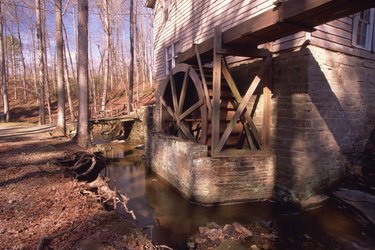Things You'll Need
1/4-inch plywood sheet
Saw
Finishing nails
Hammer
Wood glue
5-inch by 1/2-inch dowel
Drill
Garden hose

A watermill is a basic work energy generator. Created in ancient times, the watermill was originally attached to mechanical gears and shafts to drive grinders and mill wheels used for processing wheat and other types of grains. In the Industrial Revolution, watermills began to be connected to electrical generators to produce power. The basic concept of a watermill is simple, and you can create a small one with some basic materials and a water source.
Step 1
Cut out three 1-foot by 1-foot square pieces of 1/4-inch plywood with the saw. Lay one piece flat on your work surface. Stand the other two pieces up vertically, centered on top of the first piece 3 inches apart, then attach them with finishing nails through the first plywood piece to create the watermill base. Strengthen the joint with wood glue spread along the seams.
Video of the Day
Step 2
Cut two 12-inch diameter circles from the plywood sheet to create the watermill's wheel hubs. Drill a 1/2-inch hole through the center of each wheel hub.
Step 3
Cut four 2-inch by 5 3/4-inch rectangles from the plywood to create the watermill's spokes. Lay one of the 12-inch wheel hubs flat on your work surface and place the 5-inch by 1/2-inch dowel in the center hole without gluing it. Glue one long side of each spoke and place them evenly around the wheel hub so that each spoke touches the circle's edge and the central dowel. Let the glue dry for one hour, remove the dowel, turn the wheel assembly over and secure the spokes with nails through the wheel hub.
Step 4
Flip over the wheel assembly and place wood glue on the uppermost edges of the spokes. Place the other hub on top, using the wood dowel as a guide. Hammer nails through the wheel hub into each spoke and let the glue dry for an hour.
Step 5
Drill a 1/2-inch hole through the vertical supports of the watermill base, centered about 3 inches from the top of the supports. Make sure that the holes are aligned.
Step 6
Place the watermill wheel between the vertical supports of the watermill base. Push the dowel through the holes in the base supports and wheel hubs so that 1/2 inch of the dowel protrudes from one side and about 2 inches protrude from the other. Carefully tap a small finishing nail through the dowel on the outside of each vertical support.
Step 7
Apply wood glue on all seams where the spokes meet the central dowel. Let dry for an hour, then repeat so that the seams are all watertight.
Step 8
Place the watermill under the spout of a garden hose or other water source. It should spin easily.
Tip
To turn your watermill into a working machine, attach the protruding part of the dowel to gears or to a small electrical generator.
Video of the Day